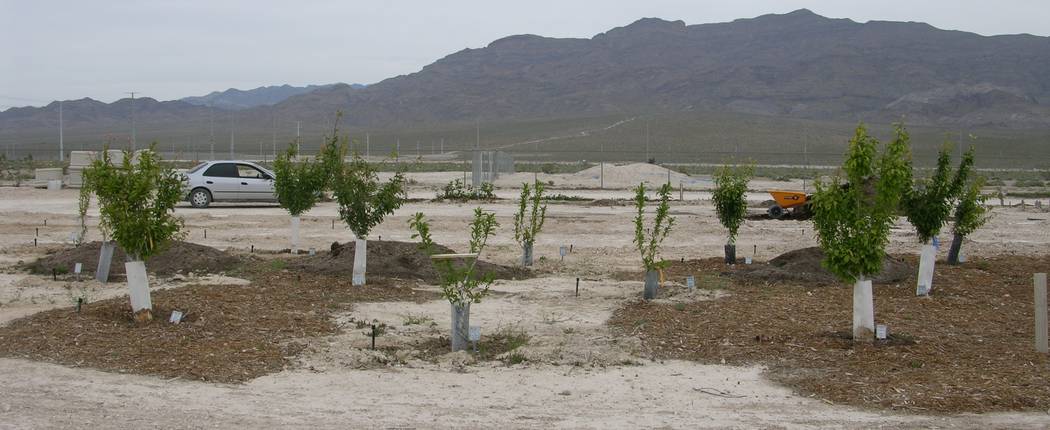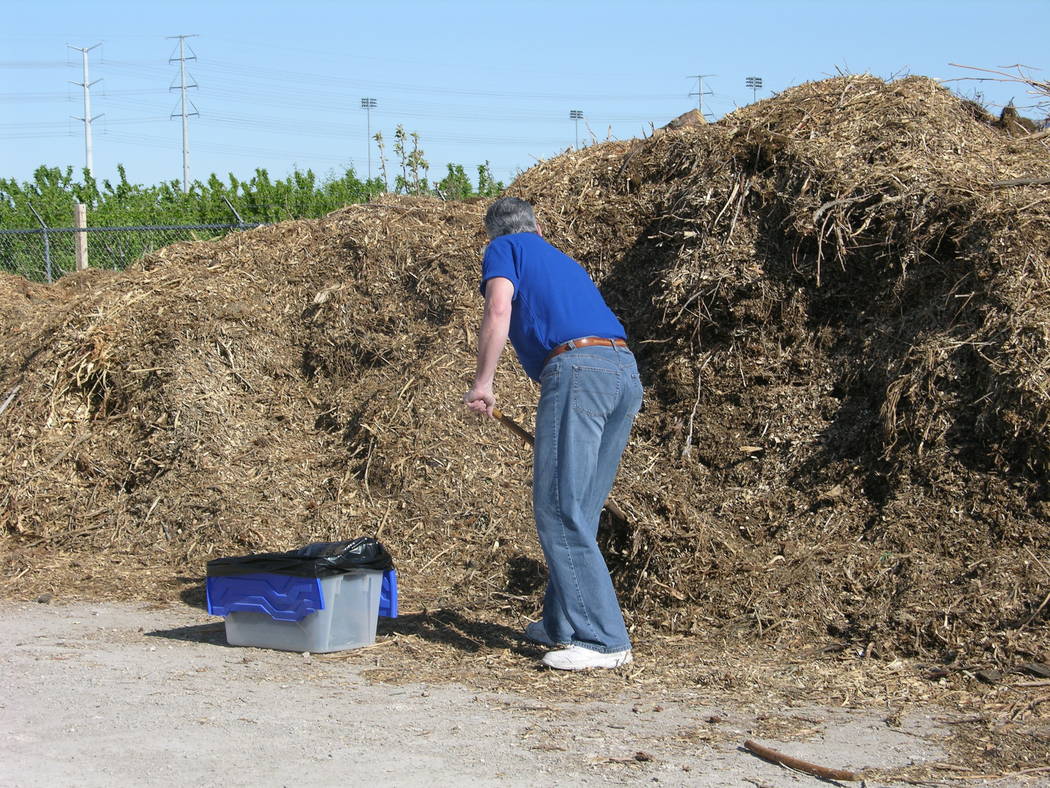Study shows mulch is beneficial to fruit trees
Q: Could you provide me with a copy of the mulch trial you conducted on fruit trees several years ago? You randomly applied mulch to different fruit trees and grew some without mulch and had some remarkable results.
A: I conducted this mulch trial in 2009-2011 with First Choice Tree Service using bare-root fruit trees planted in our desert soils using 50 percent compost mixed with raw desert soil in an equal volume.
Mulch is a layer, or “blanket,” applied to the surface of soil. Surface mulch can be made from many different things: wood, bark, rock, newspaper, cardboard or even plastic sheeting. But if applied to the surface of the soil and left undisturbed, it is considered surface mulch or just plain mulch.
A 50 percent mixture of compost and desert soil in a volume-to-volume ratio means, for instance, 5 gallons of compost mixed with a 5-gallon bucket of raw desert soil. In a few months of watering, this results in soil with 5 to 10 percent organics, not 50 percent. If you want to understand why, attend some of my classes.
Peaches, plums and pluots were planted into holes about 3 feet wide and deep enough to accommodate their roots. The holes were not deeper than this because water added to planting holes drained water in less than six hours.
Fruit trees were planted using a 50 percent (volume/volume) mixture of compost and raw desert soil. All fruit trees were staked the first growing season and pruned in the same way after planting.
No fertilizer was applied except for phosphorus to the bottom of the planting hole at the time of planting. The compost furnished all of the plant nutrients needed the first growing season.
All fruit trees were watered the same using a 3-foot-wide basin, 4 inches deep, filled with water each time they were watered. All trees were staked and surrounded by chicken wire to prevent rabbit damage.
Half of the fruit trees were randomly mulched with a 4- to 6-inch layer of wood chips made from local trees removed from home landscapes. The wood-chip mulch was provided by First Choice Tree Service. The other half of the fruit trees were surrounded by bare soil.
Mulch was kept 12 inches away from the tree trunks. The mulch was made from a variety of local trees, not including palm and mesquite.
At the end of the first growing season, fruit trees surrounded by surface mulch were more than twice the size of those without surface mulch.
This mulch is available for free, if you pick it up, from the University Orchard in North Las Vegas. This mulch is made available to the Orchard by First Choice Tree Service. If you want a large volume delivered, contact First Choice Tree Service.
Q: I’m planting new fruit and landscape trees and shrubs this year. There is a consensus on the internet that trees and shrubs should be backfilled with native soil without using amendments such as compost. However, is there an exception in Las Vegas, with our soil so exceptionally poor?
A: Yes, you are right. If you read recommendations from universities and extension advocates across the country, they will tell you not to use soil amendments at the time of planting fruit trees, landscape trees and shrubs. I am alone in the scientific community when I advocate mixing soil amendments such as compost to our soils at planting time.
In most climates and soils throughout the world, they are right. It is not needed. But it is needed here.
Soils in Southern Nevada are normally low to extremely low in soil organics — less than 1 percent. The research supporting no soil amendments was done with soils with a relatively high organic matter content (compared to ours), 5 percent or higher, which is very different from ours.
Soils are a mixture of minerals, organics and open spaces. The open spaces are needed by plant roots to breathe and hold water at the same time. The plant needs both air in the soil and water, so the plant doesn’t die of drought. Too much of one or the other, occupying the same spaces, results in poor plant performance or plant death.
Desert soils previously in farmland have much higher organics than native or raw desert soils which were never farmed. Organic content resulting from dead plants and animals is due to rainfall or irrigation. The higher the rainfall or irrigation, which results in more plant and animal life, the higher the percentage of organics in the soil.
Soils in the Mojave Desert that were never irrigated have extremely low organic matter content. This is because our desert receives less than 4 inches of water each year but could consume much more than this each year if water were available and crops were grown.
If planting without soil amendments, the existing soil organic content should be about 5 percent for most trees and shrubs. Vegetables and flowerbeds need about 10 percent. If your soil organic content is lower than this, add 100 percent compost and thoroughly mix it.
Another option is to buy enough soil mix to fill planting holes around the tree roots. Soil mixes, in my opinion, are like Hamburger Helper; they are convenient and easier to use than mixing the soil yourself but lower in overall quality than mixing it yourself. Soil mixes add bulk to a soil, while compost adds a high percentage of air or “fluff” to the soil.
Don’t add too much organics to the soil. Adding organics to a soil when enough is already present is a waste of money and works against plant establishment and growth. This is why you are confused. Many soils have enough organics in them. Ours doesn’t. This is the reason scientists saw no benefit when adding more.
How do you know if your soil has enough or not? Look at its color and how easily it digs. Soil color is a good indicator of soil organics. Rich soils, full of organics, are brown to black. Light tan or whitish soils do not have enough.
Dig in the soil. If you need a pick to dig or a shovel barely scrapes the surface, it needs organics. Organics added to the soil improve its digability.
Compost or soil mix? Soil mixes add bulk or volume. If you need to fill a space, then buy a soil mix. If you have enough or nearly enough volume, then buy 100 percent compost and mix it with the existing soil.
How much compost to add? If the soil is light-colored and extremely hard, start with an equal amount of compost mixed with your soil. In other words, 50/50 or 1:1 by volume. For instance, add a 5-gallon bucket of compost to a 5-gallon volume of soil.
Adding compost in an equal volume to poor soil does not result in 50 percent organic content but probably around 5 percent after watering, settling and growing for a few months.
Q: Please help. I have “baby” Joshua trees at the base and up to 12 inches from an adult tree. Can those be transplanted?
A: Not all Joshua trees make baby Joshua trees at their base. Joshua trees growing in the wild from higher elevations tend to produce more baby Joshua trees than those growing at lower elevations.
This may be because these babies, or pups as they are called, are needed for survival at higher, colder elevations. Perhaps your Joshua tree came from a higher elevation.
If you want to transplant these pups, dig the soil between the mother and pup so that the rhizome or underground stem (it’s like an umbilical cord) is seen and cut it. Put the soil back and water it. Water everything as you normally would.
With normal landscape irrigations, these pups will grow their own roots once removed from the mother’s “umbilical” rhizome. Give them one growing season to put down their own roots. After one season of growth, move these pups and transplant them into their new home. Spring or fall is a good time to move it.
Bob Morris is a horticulture expert and professor emeritus of the University of Nevada, Las Vegas. Visit his blog at xtremehorticulture.blogspot.com. Send questions to Extremehort@aol.com.























